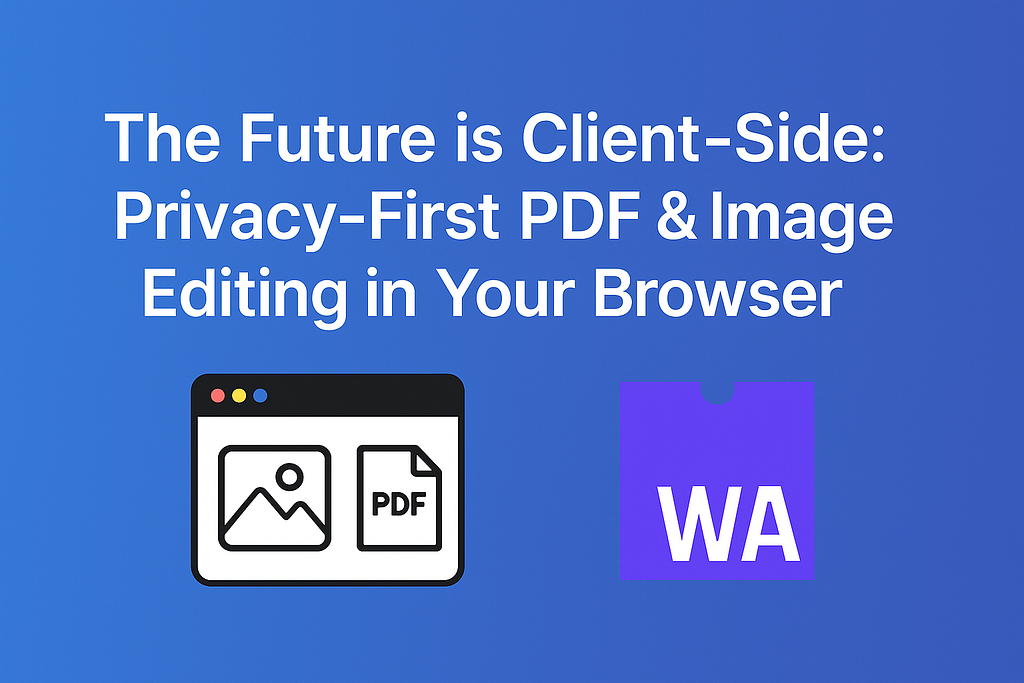Privacy-First Web Tools: Why Client-Side Processing is the Future
How WebAssembly is powering a new generation of browser-based tools that never upload your files

The Problem With Sending Your Files to the Cloud
Have you ever stopped to think about what happens when you use an online tool to edit a PDF or modify an image?
In most cases, your file travels across the internet, lands on someone else’s server, gets processed there, and then returns to you. During this journey, your data:
- Is vulnerable to interception
- Becomes inaccessible if your internet drops
- Might be stored on servers long after you’re done
- Experiences delays while waiting for server processing
- Could potentially be accessed by the service provider
For sensitive documents, personal photos, or confidential business files, this standard approach feels increasingly outdated and unnecessarily risky.

Enter Client-Side Processing: Your Browser as a Powerhouse
What if your browser could handle everything locally? No uploads. No waiting. No privacy concerns.
This isn’t just a hypothetical scenario — it’s the reality being built by companies like Flux8 Labs, where we’re developing tools that keep your data firmly on your device while still providing powerful editing capabilities.
The Four Pillars of Client-Side Processing
- Privacy by Design: Your files never leave your device, creating an inherently secure workflow
- Instantaneous Results: No upload/download cycles means immediate feedback
- Resilient Functionality: Work continues even when your internet connection doesn’t
- Reduced Environmental Impact: Less data transfer means lower energy consumption
The Technology Making It Possible: WebAssembly (WASM)
Behind this revolution is WebAssembly — a game-changing technology that brings near-native performance to web applications.
“WebAssembly represents the biggest shift in web capabilities since AJAX.” — Web Platform Quarterly Report, 2024
WASM allows developers to compile code written in languages like C, C++, and Rust into a format that browsers can execute with remarkable efficiency. This means complex operations that previously required server infrastructure can now happen directly in your browser.

Real-World Applications Already Emerging
The potential applications are vast and growing daily:
- PDF Processing: Split, merge, annotate, and sign documents locally
- Image Manipulation: Resize, crop, compress, and apply filters instantaneously
- Video Editing: Cut clips and apply effects without massive uploads
- Data Analysis: Process spreadsheets and visualize results without sharing sensitive data
- File Format Conversion: Transform documents between formats securely
The User Experience Difference
Imagine working with a 50MB video file or a sensitive legal document. With traditional cloud tools, you’d:
- Upload (waiting…)
- Process on server (waiting…)
- Download result (waiting…)
- Hope your data is deleted afterward (uncertainty…)
With client-side processing:
- Load the tool once
- Process immediately with real-time feedback
- Save directly to your device
- Know with certainty your data never left your control
The difference isn’t just technical — it fundamentally transforms how users interact with and trust web applications.
Our Vision at Flux8 Labs
At Flux8 Labs, we’re building the next generation of privacy-respecting web tools:
PDF Editor (In Development)
Our browser-based PDF tool will let you annotate, split, merge, and sign PDFs without ever uploading them. Security-conscious professionals can finally edit documents with confidence.
Image Editor (Coming Soon)
A comprehensive solution for image manipulation — from simple crops to complex filters — all processed locally in your browser with professional-grade results.
Developer-Friendly Architecture
We’re designing our tools with modularity in mind, allowing developers to integrate our technology or build their own secure, client-side processing solutions.
The Challenges We’re Solving
Client-side processing isn’t without challenges:
Performance Variations
Different devices have different capabilities. We’re implementing adaptive approaches that deliver optimal experiences across hardware configurations.
Initial Load Optimization
WASM modules can be large. We’re using code splitting, lazy loading, and other techniques to ensure fast initial loads while maintaining functionality.
Browser Compatibility
While WebAssembly support is now widespread, we’re implementing graceful fallbacks to ensure nobody gets left behind.
The Bigger Picture: A Shift in Web Philosophy
This movement toward client-side processing represents more than just technical innovation — it signals a philosophical shift in how we think about the web:
- From centralized to distributed computing
- From data collection to data sovereignty
- From “free service in exchange for your data” to “tools that respect your privacy”
What’s Next for This Technology?
The future of client-side processing looks incredibly promising:
- AI at the Edge: Machine learning models running locally for intelligent document processing
- Cross-Device Synchronization: Work seamlessly across devices while maintaining privacy
- Progressive Enhancement: Advanced features that adapt to your device’s capabilities
- Interoperability: Standards that allow different client-side tools to work together
Join the Client-Side Movement
Whether you’re a developer, business owner, or privacy-conscious individual, there are ways to participate in this shift:
- Demand Better Tools: Ask service providers about their privacy practices and whether they offer client-side alternatives
- Support Pioneers: Use and share tools that respect your privacy through client-side processing
- Contribute: If you’re a developer, consider how your next project could benefit from this approach
The Future is Client-Side
As users become increasingly aware of privacy concerns and businesses recognize the benefits of reduced server costs, client-side processing will continue its momentum toward becoming the new standard.
The question isn’t whether this shift will happen, but how quickly — and which companies will lead the way.
Interested in learning more about our privacy-first tools? Visit flux8labs.com to explore our projects and upcoming releases..